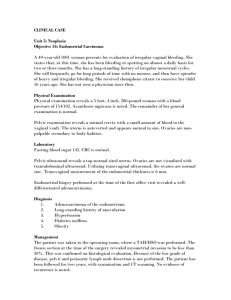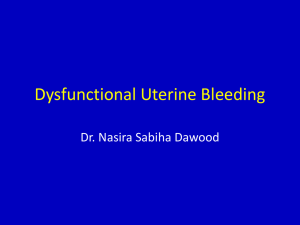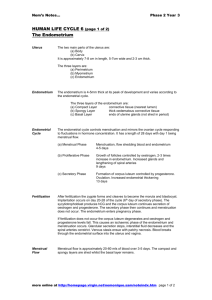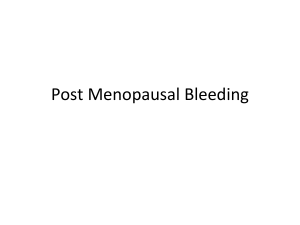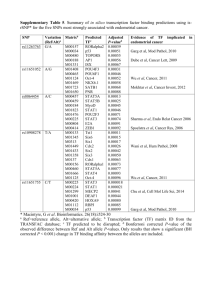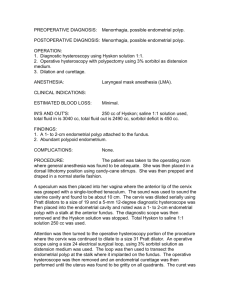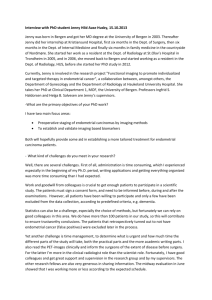48x36 Poster Template
advertisement
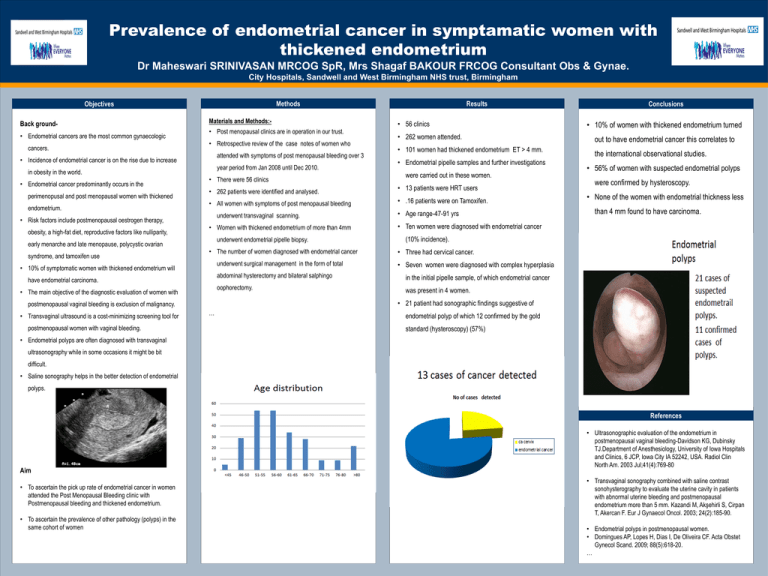
Prevalence of endometrial cancer in symptamatic women with thickened endometrium OPTIONAL LOGO HERE OPTIONAL LOGO HERE Dr Maheswari SRINIVASAN MRCOG SpR, Mrs Shagaf BAKOUR FRCOG Consultant Obs & Gynae. City Hospitals, Sandwell and West Birmingham NHS trust, Birmingham Methods Objectives Back ground• Endometrial cancers are the most common gynaecologic cancers. Materials and Methods:• Post menopausal clinics are in operation in our trust. • Retrospective review of the case notes of women who attended with symptoms of post menopausal bleeding over 3 • Incidence of endometrial cancer is on the rise due to increase in obesity in the world. • Endometrial cancer predominantly occurs in the perimenopusal and post menopausal women with thickened endometrium. • Risk factors include postmenopausal oestrogen therapy, obesity, a high-fat diet, reproductive factors like nulliparity, early menarche and late menopause, polycystic ovarian syndrome, and tamoxifen use year period from Jan 2008 until Dec 2010. • There were 56 clinics • 262 women attended. • 101 women had thickened endometrium ET > 4 mm. • Endometrial pipelle samples and further investigations were carried out in these women. • 262 patients were identified and analysed. • All women with symptoms of post menopausal bleeding • .16 patients were on Tamoxifen. underwent transvaginal scanning. • Women with thickened endometrium of more than 4mm underwent endometrial pipelle biopsy. • The number of women diagnosed with endometrial cancer underwent surgical management in the form of total have endometrial carcinoma. • The main objective of the diagnostic evaluation of women with • Age range-47-91 yrs Conclusions • 10% of women with thickened endometrium turned out to have endometrial cancer this correlates to the international observational studies. • 56% of women with suspected endometrial polyps were confirmed by hysteroscopy. • None of the women with endometrial thickness less than 4 mm found to have carcinoma. • Ten women were diagnosed with endometrial cancer (10% incidence). • Three had cervical cancer. • Seven women were diagnosed with complex hyperplasia abdominal hysterectomy and bilateral salphingo in the initial pipelle sample, of which endometrial cancer oophorectomy. was present in 4 women. • 21 patient had sonographic findings suggestive of postmenopausal vaginal bleeding is exclusion of malignancy. postmenopausal women with vaginal bleeding. • 56 clinics • 13 patients were HRT users • 10% of symptomatic women with thickened endometrium will • Transvaginal ultrasound is a cost-minimizing screening tool for Results … endometrial polyp of which 12 confirmed by the gold standard (hysteroscopy) (57%) • Endometrial polyps are often diagnosed with transvaginal ultrasonography while in some occasions it might be bit difficult. • Saline sonography helps in the better detection of endometrial polyps. References Aim • To ascertain the pick up rate of endometrial cancer in women attended the Post Menopausal Bleeding clinic with Postmenopausal bleeding and thickened endometrium. • To ascertain the prevalence of other pathology (polyps) in the same cohort of women TEMPLATE DESIGN © 2008 www.PosterPresentations.com • Ultrasonographic evaluation of the endometrium in postmenopausal vaginal bleeding-Davidson KG, Dubinsky TJ.Department of Anesthesiology, University of Iowa Hospitals and Clinics, 6 JCP, Iowa City IA 52242, USA. Radiol Clin North Am. 2003 Jul;41(4):769-80 • Transvaginal sonography combined with saline contrast sonohysterography to evaluate the uterine cavity in patients with abnormal uterine bleeding and postmenopausal endometrium more than 5 mm. Kazandi M, Akşehirli S, Cirpan T, Akercan F. Eur J Gynaecol Oncol. 2003; 24(2):185-90. • Endometrial polyps in postmenopausal women. • Domingues AP, Lopes H, Dias I, De Oliveira CF. Acta Obstet Gynecol Scand. 2009; 88(5):618-20. …

